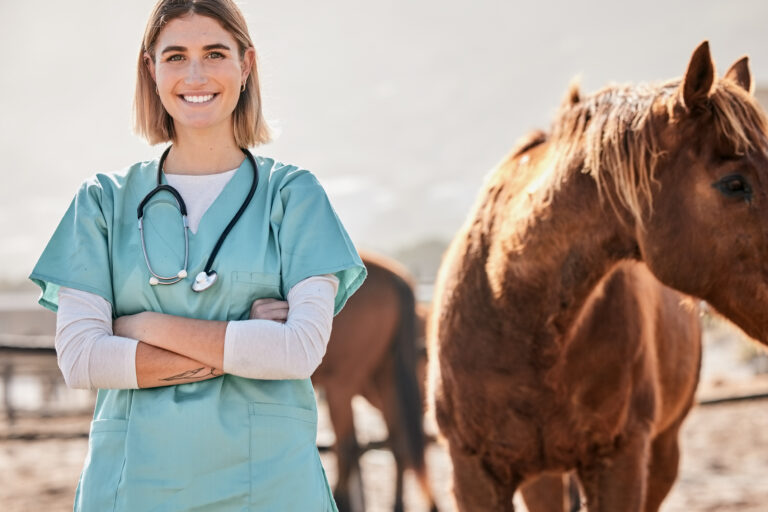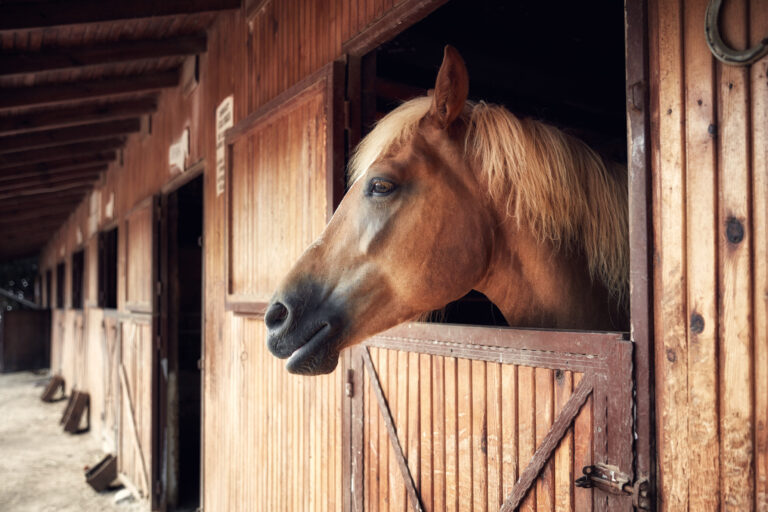
Arnd Bronkhorst Photography
It is common practice to use an oral omeprazole product (1 mg/ kg daily for 28 days) in equine athletes to try to stave off development of gastric ulcers that could be related to stress conditions. Those conditions could include training, competition or transport as well as changes in routine, herd dynamics, stabling and feeding. Reports have shown that equine gastric ulcer syndrome (EGUS) develops in 63-93% of horses in active training.

This article is brought to you by
Boehringer Ingelheim.
One study examined prophylactic use of oral omeprazole at varying doses and its effect on prevention of EGUS and severity of ulcers [Mason, L.V.; Moroney, J.R.; Mason, R.J. Prophylactic therapy with omeprazole for prevention of equine gastric ulcer syndrome (EGUS) in horses in active training: a meta-analysis. Equine Veterinary Journal (2019), vol. 51; pp. 11-19.; DOI: 10.1111/ evj.12951]. This open access article can be found here.
The meta-analysis looked at 654 horses in training that were ages 1-11 years within seven previous studies. The results indicate that “omeprazole prevented squamous gastric ulceration in horses in training. For those horses not given any prophylaxis, 77% developed gastric ulceration compared to 23% of the prophylactically-treated group. For horses with no previous history of ulceration, omeprazole prophylaxis reduced the relative risk of gastric ulcers by 70%. For horses with a prior history of ulceration, omeprazole prophylaxis reduced the relative risk of gastric ulcers by 87%, possibly due to a longer treatment time of 56 days related to initial treatment time to deal with existing ulcers in addition to the prophylactic regimen.”
Omeprazole doses used ranged from 0.5 to 4 mg/kg. It was noted that there was no difference in risk ratio for ulcer prevention between 1 and 2 mg/kg dosages. (The FDA-approved label dose of Ulcergard is 1 mg/kg.)
Based on the study findings, it is thought that omeprazole prophylaxis could result in 556 per 1,000 (55.6%) fewer athletic horses developing squamous gastric ulceration.
There have been no studies on the use of prophylactic administration for longer than 28 days.
The meta-analysis report stated “It appears from the high prevalence, high efficacy and low incidence of any adverse event associated with the medication that prophylaxis should be continued for as long as a horse is in an ulcerogenic training environment.”
Omeprazole Treatment: Oral vs. Injectable
Oral omeprazole has been the mainstay as a proton pump inhibitor for treating gastric ulcers that involve the squamous epithelium. Despite good results in many cases, 13-27% of horses do not respond to the four-week treatment protocol. Clinical response varies in individuals based on how much is degraded in the stomach, how much is bioavailable when administered at the time of feeding (particularly of feeding forage), and the variability in how well the drug is absorbed from the gastrointestinal tract.
A new formulation of a long-acting injectable omeprazole (LAIO) product has been investigated to look for improvement in response to therapy, especially for those individuals that are refractory to oral treatment. LAIO is reported to effectively suppress acid production. A study in Thoroughbred racehorses found that squamous gastric ulcers in all 22 horses healed when they were administered two once-weekly doses of long-acting omeprazole.
A recent UK retrospective study using products licensed in that country examined 12 months of case records and gastroscopy images in a different population of horses than racehorses presented to a referral veterinary hospital. The objective was to compare healing of gastric ulcers from either a long-acting injectable omeprazole product or oral omeprazole [Gough, S.; Hallowell, G., et al. A study investigating the treatment of equine squamous gastric disease with long-acting injectable or oral omeprazole. Vet Med Sci (2020); DOI: 10.1002/vms3.220].
The 56 horses in the study analysis were split into two groups: a) one where a long-acting injectable omeprazole (LAIO) at 4 mg/kg was given in weekly treatments to 29 horses; and b) one where oral omeprazole (ORLO) was administered to 27 horses. Healing was assessed at 14 and 28 days into the treatment regimens. If lesions weren’t healed by 14 days, those receiving injectable omeprazole received additional two weekly injections. Out of 98 injections, three horses (5.1%) developed five localized and self-resolving reactions at the gluteal injection site.
There was no difference in rate of healing of LAIO at 14 days and ORLO at 28 days. Factors other than acid suppression might have contributed to reduced healing at 14 days. By 28 days, this study’s results indicate that four weeks of long-acting injectable omeprazole achieved healing in 97% of horses compared to 67% in those receiving oral omeprazole. (Previous studies report healing of 73-87% with oral omeprazole.) Fasting horses prior to administration of oral omeprazole improves bioavailabilty of the drug and response to treatment.
Transport and Gastric Ulceration
Physiologic stress responses of increased heart rate, increased serum cortisol concentrations, alterations in eating and drinking, and changes in the gastrointestinal microbiome are associated with equine transport. Transportation is a known stressor that increases the risk of horses developing gastric ulcers. An Italian and Australian collaborative study evaluated 26 Standardbred, Thoroughbred and warmblood mares in their gastric responses to 12 hours of transport [Padalino, B.; Davis, G.L.; Raidal, S.L. Effects of transportation on gastric pH and ulceration in mares. Journal of Veterinary Internal Medicine (2020), vol. 34; pp. 922-932; DOI: 10.1111/jvim.15698].
Initially, 12 mares were confined for 12 hours overnight, and gastric fluid pH was assessed every two hours via indwelling nasogastric tubes (NGT) to evaluate the effects of 12 hours without feed on gastric pH and ulcer scores. In the second part of the experiment, conducted two weeks later, 26 mares were transported (in two groups of 13) overnight for 12 hours. The 12 horses used in the first part of the study with an overnight fast were included in the transport, with six in each of the two
- Seven mares received feed less than 60 minutes prior to transport.
- A second group of seven horses were fed six hours prior to transport.
- The original group of 12 from the initial overnight study were fasted and water withheld 12 hours before gastroscopy and NGT placement prior to departure. Gastric fluid was aspirated from indwelling nasogastric tubes every two hours.
- Endoscopic exam was performed both before and after transport to assess for gastric ulceration. The summary of results are as follows:
- Gastric squamous ulcer scores increased with transport, especially in those horses that were fasted prior to transport.
- The 12 horses that were confined and fasted prior to transport did not develop increased ulcer scores, but that changed following transport.
- Gastric emptying was delayed after transport in horses fed before departure.
- Gastric fluid increased in its pH, possibly from alkaline small intestinal content and impaired gastric emptying. This was in contrast to low gastric fluid pH in the 12 horses confined and fasted prior to transport.
- It is possible that duodenal bile salts and short-chain fatty acids mediated injury to gastric mucosa during transport.
- Horses fed either one hour or six hours before transport did not have elevated pH of gastric fluid upon post-transport exam. However, it took up to two hours to scope these individuals because the 12 horses fitted initially with NGT tubes were scoped first. That time lag might have allowed gastric function to return to normal by the time of their scoping. Additionally, it is possible that retention of feed in the stomach elicits more gastric acid secretion than occurred in fasted individuals, resulting in lower pH scores.
- Squamous ulcer scores resolved spontaneously by 60 hours post transport in 12 horses, but six needed omeprazole treatment due to increased ulcer scores relative to the start of transport.
The study concluded: “There was unequivocal identification of gastric ulceration (ESGD) associated with transportation of fasted horses.”
The researchers recommend that horses should have access to feed until the time of departure and possibly during transport to help limit contact of squamous mucosa with gastric secretions and small intestinal reflux. Based on the finding of increased gastric pH, there is some speculation that proton pump inhibitors might not be helpful prior to transportation, but they are certainly helpful following transport stress.
Equine Glandular Gastric Disease
It has become apparent that there are two forms of gastric ulcers: squamous ulcers (ESGD) and glandular ulcers (EGGD). Their etiology seems to differ, with the most significant risk factors of EGGD being exercise frequency and stress.
A recent publication summarizes steps to diagnose and manage the EGGD syndrome [Banse, H.E., and Andrews, F.M. Equine glandular gastric disease: Prevalence, impact and management strategies. Veterinary Medicine: Research and Reports July 2019, vol. 10; pp. 69-76; http://doi.org/10.2147/VMRR.S174427].
Clinical signs of EGGD are somewhat variable: poor body condition, weight loss, poor appetite, poor performance, behavioral abnormalities and intermittent colic. Endoscopic examination to visualize the stomach lining is the most reliable diagnostic technique.
Some breeds and athletic disciplines seem to be more at risk, with the highest prevalence found in sporthorses and warmblood show jumpers. Other studies have identified increase risk of EGGD in polo horses and Thoroughbred racehorses experiencing decreases in performance output.
In general, horses asked to exercise Five to seven days a week are more at risk of EGGD compared to those exercising one to four days per week.
Because the glandular gastric mucosa is continually exposed to gastric acid, the inciting factors for mucosal damage are likely to be related to a breakdown of protective factors. Proton pump inhibitors are not as effective in eliciting a favorable response to treatment as is recognized with ESGD.
Disruption of the hydrophobic surface of the stomach can result in increased back diffusion of hydrochloric acid and mucosal damage. Neither NSAIDs nor Helicobacter spp. appears to contribute to development of EGGD.
The most prevalent risk factor for EGGD appears to be increased stress and sensitivity to stress. Cortisol might have a local effect on prostaglandin production and contribute to ulcer formation and impedance of healing. While inflammation is found in glandular mucosal lesions, more research is necessary to establish a link between intestinal inflammation and glandular ulcers.
The primary strategies for management and prevention of EGGD currently focus on reducing exercise frequency and duration. While diet has less significance for EGGD prevention than for ESGD, there are still concerns that reduced pasture turnout, an increase in high-grain diets and the frequency of feedings might play a role.
Omeprazole has established efficacy for treatment and prevention of ESGD, but less so for EGGD. To optimize bioavailability of the drug, it is important to medicate the horse with oral omeprazole at least an hour before feeding forage.
Sucralfate provides mucosal protection by forming a physical barrier and improving the hydrophobicity of the mucus layer. It might also stimulate prostaglandin E synthesis and secretion of mucus and bicarbonate.
Combining omeprazole and sucralfate was found to help healing in 63% of horses with Grade 2 glandular lesions, and 83% achieved an improvement of one grade in horses with Grade 2 lesions. Administration of these two medications must be spaced by at least one to two hours to prevent interference in bioavailability.
Misoprostol, a synthetic prostaglandin E analogue, might improve protective mechanisms of the glandular mucosa and reduce inflammatory cytokines; therefore, it might help with treatment of EGGD.
Take-Home Message
Veterinarians serve as sentries to prevention of gastric ulcers in horses, and they are knowledgeable warriors to provide treatment for gastric ulcers.
Since clinical signs can be absent or very subtle, it is up to veterinarians to help horse owners get ahead of this problem and treat it appropriately when it arises. Preventing a disease is always better than treating a disease; that is an easy conversation to have with your clients.
While ulcers are common and expected in competition horses, they can be found in many other horses whose owners might not think that the horses have lives that could be conducive to ulcer formation.
Overall, recognizing and treating gastric ulcer disease is important to the overall welfare of the horse.

This article is brought to you by
Boehringer Ingelheim.




